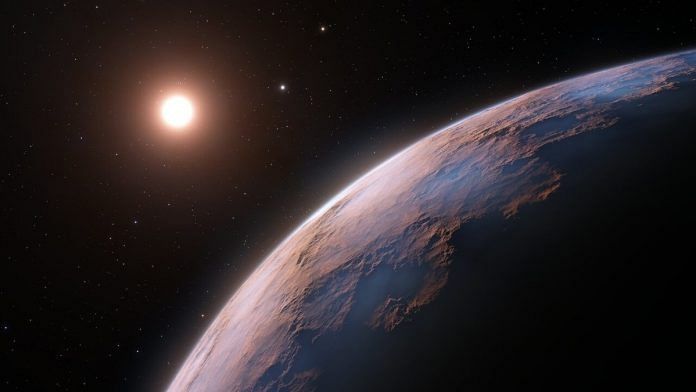Bengaluru: Astronomers have announced the evidence of a third planet around the Sun’s closest neighbouring star, Proxima Centauri, four light years away. Named Proxima d, the planet is estimated to be just about a quarter of Earth’s mass, making it one of the lightest exoplanets known, if confirmed.
“The discovery shows that our closest stellar neighbour seems to be packed with interesting new worlds, within reach of further study and future exploration,” said the study’s lead author João Faria in an accompanying statement.
The planet orbits Proxima Centauri at a distance of 4 million km, less than one-tenth the distance between Mercury and the Sun. The planet was picked up by the radial velocity method, which detects gravitational perturbations exerted by a planet and a star on each other.
Proxima d is considered to be a candidate exoplanet and will be confirmed with further follow up observations. The study was published in the journal Astronomy and Astrophysics Thursday.
Also read: Earth has a second ‘Trojan’ asteroid, will share its orbit for next 4,000 years
‘Extremely important’
Proxima Centauri hosts two other confirmed planets, Proxima b and Proxima c. They orbit the star in 11 days and 5 years, and are located 7.5 million km and 220 million km from it, respectively. Proxima b is thought to be within the star’s habitability zone.
Initial findings show that Proxima d orbits its star every five days but is too hot to be habitable. Its mass is thought to be just 25 per cent that of Earth’s. This makes Proxima d one of the lightest exoplanets known, and the lightest exoplanet detected using radial velocity.
The radial velocity technique detects tiny wobbles or perturbations in the planet’s and star’s orbit. Because two bodies exert gravitational force on each other, both the star and planet wobble under each other’s effects. This can be detected from earth and used to calculate the planet’s mass from the known star’s mass.
The discovery was made by the Echelle Spectrograph for Rocky Exoplanets and Stable Spectroscopic Observations (ESPRESSO) instrument on the European Southern Observatory’s Very Large Telescope (ESO’s VLT) in Chile.
“This achievement is extremely important,” Pedro Figueira, ESPRESSO instrument scientist, said in the statement.
“It shows that the radial velocity technique has the potential to unveil a population of light planets, like our own, that are expected to be the most abundant in our galaxy and that can potentially host life as we know it.”
Also read: Rising ‘heatwaves’ in Indian Ocean could hit monsoon, says pioneering study by Pune team



